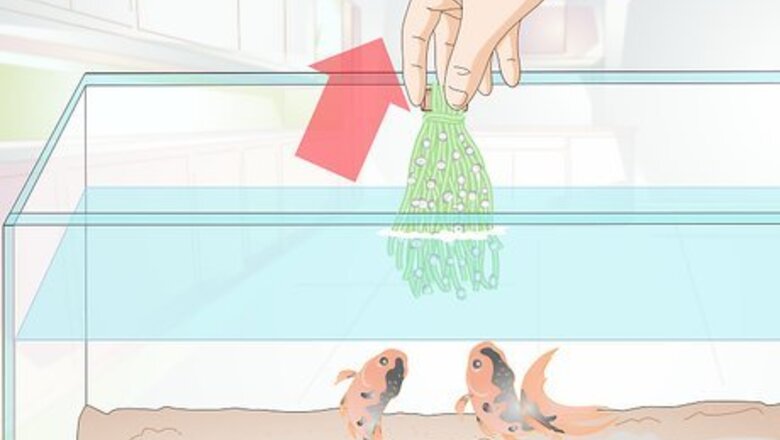
views
Preparing the Proper Environment
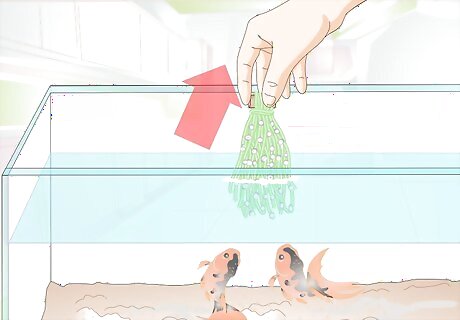
Remove the eggs from the tank. You want to remove the eggs as soon as they are laid. If you are intentionally breeding goldfish, you may have spongy material known as "spawning mops." Goldfish may also lay their eggs in fixtures in the tank, such as underwater castles. Wherever your goldfish have spawned on, remove this material from the tank. Gently flush the material in clean water. You want to make sure any debris from the tank is removed. Once the material is removed and flushed, you can transfer it to a new environment.
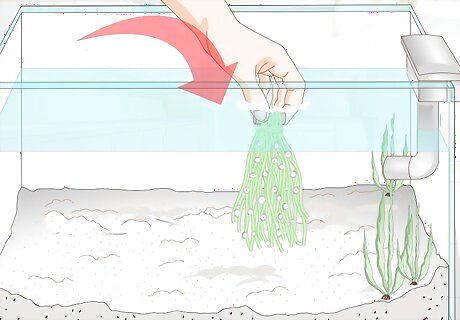
Create good hatching conditions. Once the eggs hatch, you want to make sure the conditions in your tank are safe and hospitable. Transfer your eggs to a clean environment. When you place the fry eggs in the aquarium, do not fill the tank too deep. Ideally, a fry aquarium should only have water 6 to 7 inches deep. The eggs should hatch 4 to 5 days after being laid.

Keep the tank at the right temperature. Goldfish fry require warmer temperatures than average fish to thrive. You'll need to keep the tank between 70–75 °F (21.1–23.9 °C). You may need to install a heater, which you can purchase at a local pet store, in the tank. Keep a thermometer in the tank so you can make sure the water is always around the proper temperature.
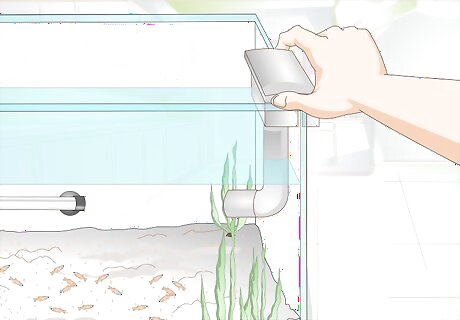
Make sure to have a filtration system. Fish tanks get dirty very easily without proper filtration, which can be particularly dangerous for young fish. Stop by your local pet store and pick up a power filter, which is a filtration system that hangs on the back of a goldfish tank. Filtration systems are generally simple to install as long as you follow instructions carefully. They can usually be fitted onto the bank of most fish aquariums. There is really no such thing as too much filtration when it comes to goldfish, as they're particularly messy. It may be a good idea to install two filters. In the event one filter gives out, a second filter can pick up the slack. Exposure to germs, even for a brief period, can be dangerous for young goldfish fry.
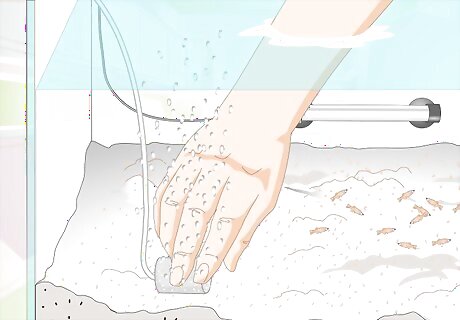
Aerate the tank. An aeration system must be put in place to make sure your fish get enough oxygen. Air stones or bubble wands, which you can purchase at most pet stores, work well for aeration in a goldfish tank. As with a filtration system, it's a good idea to have two bubble wands in place as they can clog easily. Air stones break down with time when submerged in water, so make sure to replace air stones frequently. Replace air stones when they begin to look cracked and broken down.
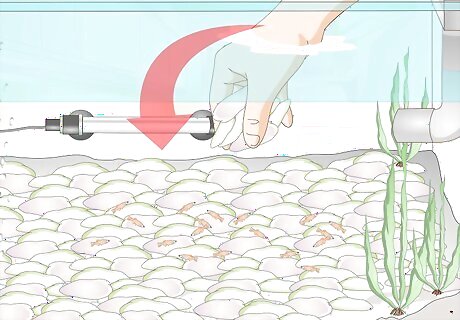
Place smooth gravel at the bottom of the tank. You should choose large, smooth bits of gravel to fill the bottom of the pond. Gravel too small could be swallowed by a goldfish. It's a good idea to look through a bag of gravel to check for jagged bits of gravel as well. Discard any pointy stones, as goldfish could scrape their stomachs.
Feeding and Upkeep

Feed the fry a healthy diet. When growing, fry should be fed several times a day. Make sure you choose a high quality fish flake that is small enough for fry consumption. Powder-based foods are generally safe for goldfish fry. This is mostly a mix of algae and processed foods and contains the right minerals and vitamins for goldfish fry. You should also provide pellets for adult fish as a supplement to their diet. You may have to break dry pellets apart before feeding them to fish fry, however, as they may be too big for the fry to eat.
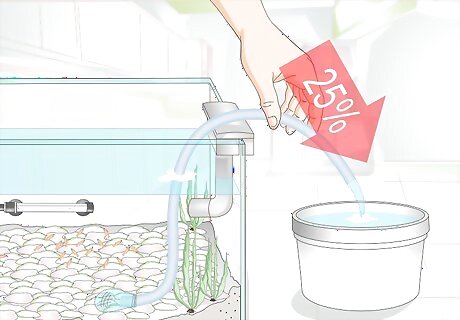
Replace the water regularly. About 25% of the tank's water should be replaced on a weekly basis. Fish fry are dirty, so their water becomes contaminated quickly. Make sure to add water of the same temperature to the tank. It can be difficult to see goldfish fry in a larger aquarium when they are very young. Therefore, be careful when you remove the water from the tank. Use a transparent container to scoop out the water. Check for any goldfish fry before disposing. If you see a goldfish fry in the water you scooped out, use a smaller container, like a small piece of Tupperware, to scoop out the goldfish fry and transfer it back into the tank.
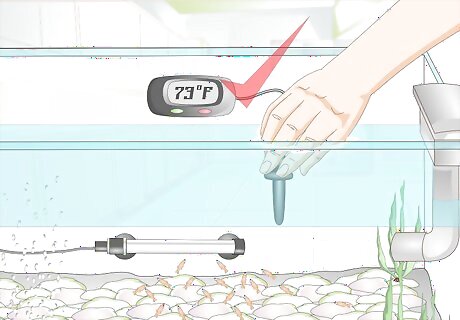
Keep the water at a steady temperature. Rapid changes in water temperature can be dangerous for goldfish fry. Remember, the water should be between 70 and 75 degrees Fahrenheit. There should not be temperature fluctuations more than a few degrees a day. If the tank's temperature fails to stay the same, you may have to install a heating system.
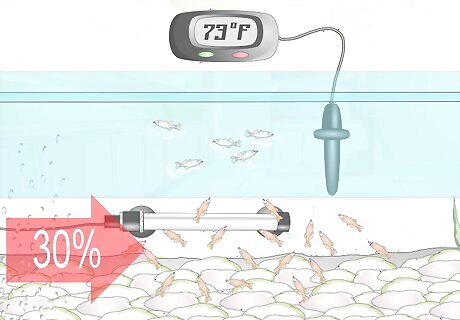
Expect to lose some goldfish fry. Even with proper care, not all goldfish fry will survive into adulthood. Unfortunately, on average only about 30% of the fry make it to adulthood. About 5% of fry are born with a deformity that kills them off quickly, and 60% will die of disease. Do not feel discouraged or at fault if only a few of your fry survive. This is a normal part of the process.
Avoiding Health Problems
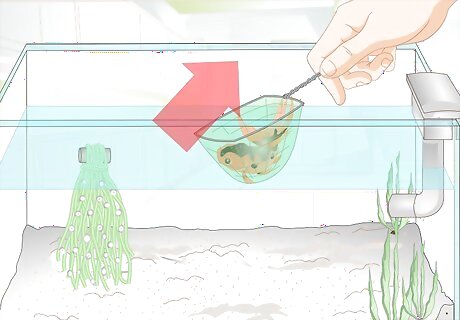
Remove the parents from the tank. Goldfish will eat their eggs, or eat the fry after they hatch. As soon as you notice eggs, remove the parents from the tank and transfer them somewhere else until the goldfish are grown. You can also remove the eggs from the tank and transfer.
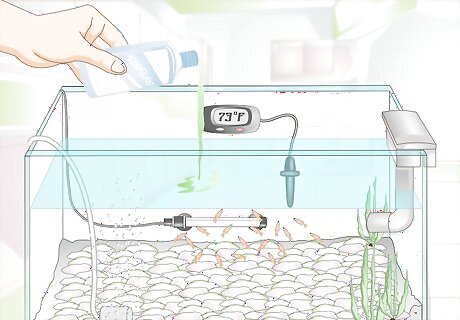
Get fluke medication. Fluke, a type of disease, can cause an unusual number of fry to die. It's a good idea to have fluke medication on hand. If you notice the fry are dying quickly, dispense the medication. You can buy fluke medication at a local pet store. There should be instructions on the box on how to administer the medication. The sooner you intervene, the better. You can save a good portion of your fry with quick intervention in the event of a fluke outbreak.
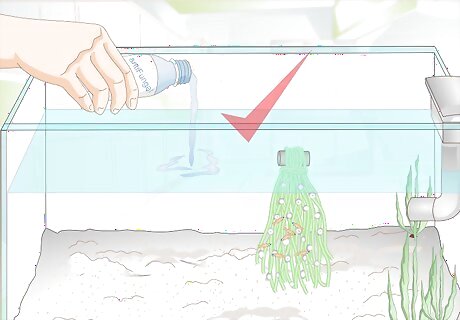
Add anti-fungal liquid to the water. Not all goldfish fry eggs are fertile. Infertile eggs will grow fungus, which can affect the development of fertile eggs. You can purchase an anti-fungal liquid at your local pet store. You should administer the recommended amount to the tank within a few days of the eggs hatching. Usually, you add enough that the water turns a blueish color.
















Comments
0 comment